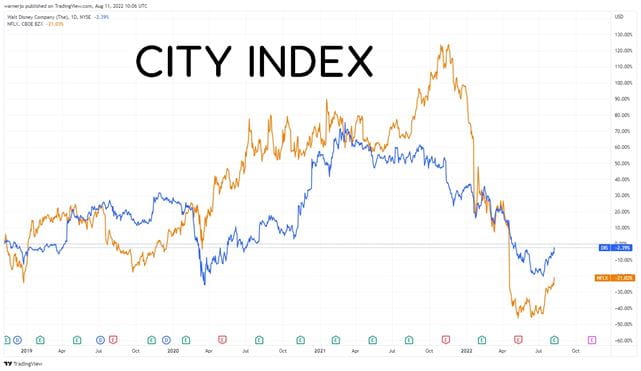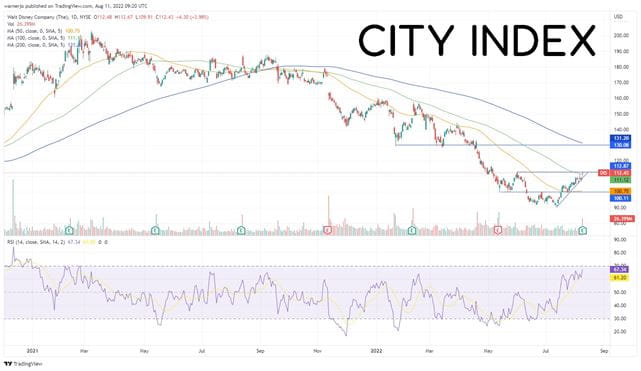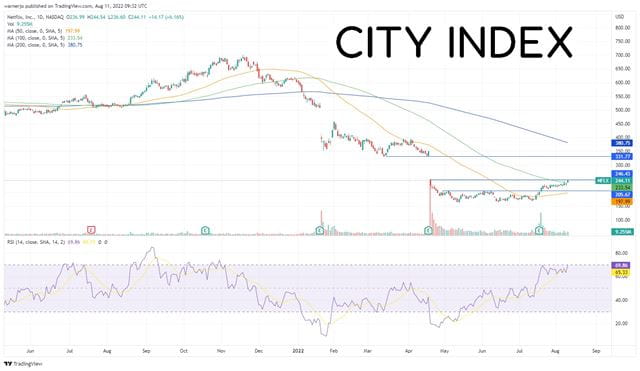
Disney subscribers surpass market-leader Netflix
Disney revealed it added 14.4 million subscribers to its Disney+ streaming service in the latest quarter, smashing past the 10.7 million additions pencilled-in by Wall Street. That means 152.1 million people were signed-up to the service in early July.
Disney also owns its sports-based service ESPN+, which acquired more users than anticipated to end the quarter at 22.8 million, while Hulu continued to grow and ended the period with 46.2 million.
Combined, this means Disney now has 221.1 million streaming subscribers on its books, edging past market leader Netflix that had 220.7 million paying subscribers at the end of June. That is all the more impressive considering Disney+ was only launched in late 2019, meaning the platform has helped propel Disney ahead of Netflix in less than three years.
Below is a table outlining the race that has heated up over the past three years, comparing the total number of paying subscribers for streaming services at each company by each quarter, which is based on the calendar year:
|
Paid Subscribers (Mns) |
Netflix |
Disney |
|
Q4 2019 |
167.1 |
63.5 |
|
Q1 2020 |
182.9 |
73.5 |
|
Q2 2020 |
193 |
101.5 |
|
Q3 2020 |
195.2 |
120.6 |
|
Q4 2020 |
203.7 |
146.4 |
|
Q1 2021 |
207.6 |
159 |
|
Q2 2021 |
209.2 |
173.7 |
|
Q3 2021 |
213.6 |
179 |
|
Q4 2021 |
221.8 |
196.4 |
|
Q1 2022 |
221.6 |
205.6 |
|
Q2 2022 |
220.7 |
221.1 |
(Source: Company reports)
Is 2022 the year Netflix loses its crown?
It is important to note that Disney has only overtaken Netflix when all its streaming services are combined. Netflix has over 90 million more subscribers than Disney+, although the latter is catching up. Disney+ is expected to have somewhere between 215 million to 245 million subscribers by 2024 alone, although this has been trimmed from an original goal of 230 million to 260 million because of lower expectations in India after losing the rights to the Indian Premier League.
This suggests Netflix will remain the single largest individual streaming platform for the time being, although the fact it has started to lose subscribers this year and expects lacklustre growth in the second half of 2022 suggests it will continue to lose ground unless its plans to revive growth pay off.
Below is what Wall Street expects in terms of subscriber growth at both companies this year and next, according to the latest consensus figures, with the figures for Disney broken down by each service:
|
Paid Subscribers (Mns) |
End of 2022 Forecast |
End of 2023 Forecast |
|
Netflix |
227.7 |
238.4 |
|
- Disney+ |
161.4 |
195.8 |
|
- ESPN+ |
24.2 |
27.6 |
|
- Hulu |
47.7 |
50 |
|
Disney Total |
233.3 |
273.4 |
(Source: Bloomberg)
Streaming wars heat up as growth slows
Following years of unabated growth in streaming, 2022 is shaping-up to be a turning point for the industry. It is becoming more difficult to grow subscribers, especially as bumper content budgets force them to push up prices at a time when consumers are becoming more cost-conscious and costs are on the rise in the inflationary environment. This has prompted both Netflix and Disney to introduce new catalysts this year.
One reason it is becoming harder to grow the subscriber base is increased competition. The video streaming market had just a handful of major players a decade ago, but there is now a flurry of options for consumers to choose from spanning from Amazon Prime Video and Apple TV+ to Paramount Plus, Comcast’s Peacock, and Warner Bros Discovery’s services HBO Max and Discovery+.
Streaming services are having to spend big on content to attract subscribers in a more competitive market, although we are starting to see some pullback as they adjust their budgets in response to slower growth and a tougher macroeconomic outlook plagued by inflation. Still, Disney is also outshining Netflix on this front with a content budget worth a whopping $32 billion in 2022. That has been trimmed by $1 billion from the original allocation, but will still mark a significant step up from the $25 billion spent in 2021. Meanwhile, Netflix’s board has suggested its content spend could remain flat from the 2021 budget of $17 billion over the coming years.
Streaming companies are starting to become more stringent with their spending, and for good reason. Netflix has been profitable for years, although it took some time to get there and its bottom-line is now coming under pressure as growth slows and cost rise. Meanwhile, Disney+ isn’t expected to be profitable until 2024 and its TV streaming unit booked a loss of $1.1 billion in the latest quarter alone as it ramped-up investment in content and expanding into new countries. But Disney has more than enough firepower from its array of other operations including but not limited to theme parks, resorts, cruises and cinema releases – all of which are delivering bumper profits after being hit during the pandemic - to generate the cash needed to grow its streaming platform.
We have seen a dramatic shift in attitude as things have become tougher this year. Executives at Netflix said as recently as 2020 that they would never bring advertisements to its platform but were forced to eat their words earlier this year when they unveiled plans to launch an ad-supported service in an effort to revive growth. Netflix believes there are over 100 million households that enjoy its services but don’t pay, prompting it to introduce new pricing tiers in the hope of converting as many of them as possible into official users. The fact Netflix has had to continually hike prices in recent years to help fund its content has also pushed it out of reach for some, so Netflix hopes launching an ad-based version can provide a more affordable option – especially as consumers scour bills for subscriptions and other costs to cut amid the cost-of-living crisis. Netflix has not yet confirmed the pricing plan for its ad-supported version, but we know the cost of Netflix’s standard subscription in the US has almost doubled from $7.99 back in 2013 to $15.49 today.
Disney has revealed it will too will launch an ad-supported version in early December 2022. Notably, it has already shown its hand and said this will still cost users $7.99 per month. That is the same price as what it currently charges for its ad-free version, although this is being hiked to $10.99 when the new tier is introduced. This is significant as Disney has shown its confidence that people are willing to pay for ads, in stark contrast to other major streaming sites that offer their ad-supported versions for free, such as Spotify or YouTube.
Disney vs Netflix: Who is winning the streaming war?
Disney and Netflix now find themselves in very different positions. The stalling growth this year has sparked concerns that Netflix has already reached its peak, giving it a big job to do in reviving growth. Meanwhile, Disney is still delivering impressive subscriber growth across all of its streaming services and must keep up the momentum to avoid being tarred with the same brush.
Still, Disney is winning the war against Netflix at present. Disney now boasts more subscribers and is among the leading streaming companies in the world, delivering growth and capturing market share at a time when Netflix is struggling.
Disney offers greater diversification thanks to its other sources of income, giving it more levers to pull and other cash-generative operations to fund its streaming ambitions. This is also allowing it to outspend Netflix when it comes to content. It also has greater options for its content over Netflix as it continues to release films on the big screen, and has greater experience in advertising as both companies prepare to launch ad-supported services. Netflix is leaning on the support of Microsoft as it has never operated this type of business before.
This year will be a major test of how much value consumers assign to their streaming subscriptions. We have already seen evidence that people are becoming more selective and trying to save money in the current climate, and investors will be keen to find out how new pricing tiers and models will be received by consumers, especially as they have more options than ever to consumer content.
Disney vs Netflix: What stock has performed the best?

Netflix had largely outperformed Disney in recent years, up until 2022. Netflix shares rallied throughout lockdown as people flocked to the platform to keep them entertained whilst stuck at home, allowing it to climb to new all-time highs in late 2021. Disney underperformed as its theme parks, resorts and cruises had a tougher time during the pandemic, which overshadowed the progress being made in streaming.
However, we have seen the tables turn in 2022 after the staggering fall in Netflix’s share price as it started to lose subscribers in 2022. Disney now trades marginally below where it sat when it launched Disney+ in late 2019, while Netflix is down over 23%.
Where next for DIS stock?
Disney shares have rallied over 22% since hitting a 28-month low in mid-July and the uptrend remains firmly intact.
The stock is trading up 7.5% in extended hours trade today following the results released late last night at $120.80. This has allowed it to breeze past the June-high of $112.85 and has brought the $130 level of support seen during the first four months of 2022 back into play, in-line with the 200-day moving average. Notably, the 32 brokers that cover Disney see even greater upside potential with an average target price $143, implying there is over 27% potential upside from current levels.
The fact average trading volumes exploded yesterday, coming in more than double the 100-day average, and have been on the rise during the last 10 sessions suggests the latest results have revived interest in the stock and supports the idea that it can keep up the momentum, however the RSI is not far off overbought territory to suggest it may become harder for the stock to find higher ground.
With that in mind, the stock has recently recaptured the 100-day moving average at $111, which investors will hope can emerge as a new level of support going forward. However, the 50-day moving average at $100.75 is currently a firmer floor considering this in-line with the level of support seen during May and June.

Where next for NFLX stock?
Netflix shares have also found higher ground since hitting their lowest level since 2017 back in May, having risen over 46%. However, the stock is trading marginally lower in extended hours today at $243.70.
The stock is now trading at around its highest level in almost four months and is testing the $245 price that it opened at on April 20, when it suffered its worst single-day fall in over two decades after revealing it lost subscribers for the first time in over 10 years. A sustained break above here could allow it to bring a much larger upside target into view as it tries to recapture $333 to close the vast gap created earlier this year.
However, $245 may prove tough to crack considering the RSI is on the cusp of entering overbought territory and trading volumes have been declining over the last 10 sessions to suggest it could be losing momentum. Plus, the 46 brokers that cover Netflix see limited upside potential from current levels with an average target price of $255.
Investors will hope the 100-day moving average, currently at $233.50, can become a new level of support going forward after the stock recaptured it for the first time since the start of 2022, although the $205 level of resistance seen throughout April to June should be considered a firmer floor, followed by the 50-day moving average at $198.

How to trade stocks
You can trade both Disney and Netflix shares with City Index in just four easy steps:
- Open a City Index account, or log-in if you’re already a customer.
- Search for ‘Disney’ or ‘Netflix’ in our award-winning platform
- Choose your position and size, and your stop and limit levels
- Place the trade
Or you can try out your trading strategy risk-free by signing up for our Demo Trading Account.





